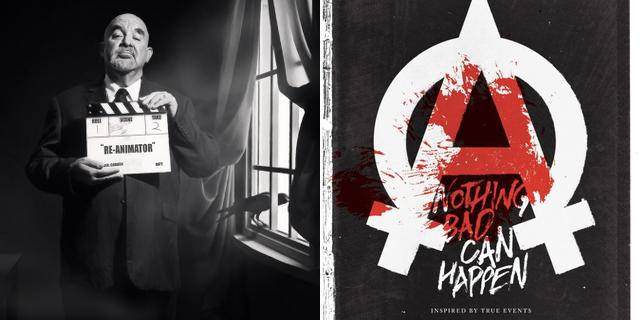Warning: Major spoilers ahead
It’s hard to dislike a movie whose opening line is “My life is a fucking nightmare,” especially when it’s spoken in voice-over by a young woman in a green turtle-hoodie who seems to be instigating her own private revolution against the world. And so I didn’t. But did I feel Felt? I certainly did in the beginning, and for a good part of its running time. Ultimately, however, much of the good will – if a violent and self-destructive acting out against the patriarchy can be construed as such – engendered in the first half of the film was squandered, for me, in the inexorable path to its harsh conclusion. But let’s start at the beginning….
Felt is an independent film directed by Toad Road director Jason Banker. It was made in close collaboration with its star, Amy Everson, a San Francisco-based visual artist whose main medium, in her reproduction of everything from faux-genitalia to masks to the human heart, is felt. Felt, as we all know, is a textile or fabric of matted, compressed fibers, both natural and synthetic, that is often used in the more crafty art practices.
The film starts out promisingly, with a series of composed yet slightly askew images of Amy accompanied by her voiceover, followed by a credit sequence of childhood toys and art objects configured in disturbing ways, with an emphasis on genital object relations. The aesthetic is indie arthouse, but the composition and montage distinguish its own style.
An early scene, in which Amy discusses with her best friend the various methods they might use to torture and/or kill men, set up, for me at least, an expectation of something along the lines of the Québécois masterpiece Sonatine, directed by Micheline Lanctôt, or Virginie Despentes’ electrifying Baise-moi, films in which a pair of young women acts out extremely against the various forms of adult indifference or sexual exploitation, both subtle and overt, that they are subject to in a misogynistic society. It’s this “Bonnie and Bonnie” bonding between female characters – suicidal in the former film, homicidal in the latter – that is so compelling and absorbing on a feminist level: outcasts in mutual revolt against an oppressive, male-dominated culture.
He isn’t scared away when Amy shows him her bedroom treasure trove of self-made art objects, such as the Goatse ceramic plate or the aborted Hitler felt fetus.But in Felt, Amy’s best friend soon disappears because she finds her behavior too odd and extreme. Another friend, a would-be model she meets at a photo shoot arranged by a creepy, bearded man on the internet, seems like she might be the partner-in-crime that Amy seeks to help wage her war, particularly when she expresses admiration for the fake-breasts-and-vagina costume that Amy has chosen for the occasion. “Sexiness is overrated. Being human is overrated,” she tells the model afterward, who relates to her political deflection of the male gaze. But sadly, she too drops out of the picture when Amy gets a boyfriend, a sensitive young man who, predictably, turns out to be too good to be true.
In the meantime, we are quite frequently with Amy by herself, which is a pretty engaging place to be – she’s an oddly beautiful, skinny, imperfect girl with a scar on the end of her nose who, in one vignette, frees a dragonfly from a spider’s web. We are left with Amy alone in the woods wearing a scarecrow-like felt mask and felt penis, or sporting a crazy-man mask and red hoodie, pulling down her pants in a graveyard to reveal her toy penis.
At times the film almost reminded me of a female version of João Pedro Rodrigues’ excellent film O Fantasma, in which a young man wears a rubber mask and bodysuit to act out his unusual, fetishistic sexual fantasies in public spaces. But Amy’s trajectory is unique in its feminist underpinnings, stemming from some incident of childhood sexual abuse only hinted at in the film. She mixes gender radically in her masquerades, becoming alternately an abject male monster and a muscular female superhero. The Freudian – or rather, Kleinian – symbolism, variously involving castration and baroque sexual object relations, is freely associated. When Amy ends up in a job promoting a fast-food joint wearing a chicken (cock) costume – with a shrewd wink to Fast Times at Ridgemont High – her project of public sexual charades is neatly reinforced.
Amy then randomly meets a seemingly harmless, somewhat passive young man (Kentucker Audley), after which Felt veers in another direction, first toward something more hopeful, before careening into absolute darkness. The boyfriend is a familiar type to feminists – sensitive, nurturing, gentle and understanding, yet perhaps using those very attributes, which may or may not be genuine, to achieve his female conquests. He isn’t scared away when Amy shows him her bedroom treasure trove of self-made art objects, such as the Goatse ceramic plate or the aborted Hitler felt fetus, or when she playfully yet violently and repeatedly sticks a needle into a felt penis. Like the song says, love is kinda crazy with a spooky little girl like her, and his cute attempts to save her with affection and caring – including a ritual rebirth through an enormous fake vagina in an art gallery – seem doomed from the start.
After a brief yet romantic beginning to their relationship, Amy’s model friend informs her that she’s seen the new boyfriend being intimate with another girl, setting off a cataclysmic chain of events. The film now enters a much more pathological stage, verging on territory explored in such psychosexual masterpieces as Vertigo, Looking for Mr. Goodbar and The Driver’s Seat, which may or may not have been consciously referenced. Amy leads her boyfriend to a redwood forest in a scene reminiscent of Vertigo, also a San Francisco-set film about female masquerade and resistance toward the male gaze and sexual control. Like a feminist twist on James Stewart, she forces her young man to wear her own fake-breast-and-vagina costume, while she dresses up in her nude male get-up replete with fake penis. “Can you zip me up, honey?” she asks him, a clever allusion to stereotypical heterosexual roles. After laying him down on a fallen tree, she mounts him, and then stabs him brutally and repeatedly to death, as if in a ritualistic sacrifice, wielding the very scissors she uses to make her costumes. Still wearing her male mask, she then cuts off his penis and wears it as her own, her fake masquerade having become, in her mind, somehow real.
Full disclosure: last year I myself made a film, an avant-garde opera called Pierrot Lunaire, in which a transman murders a taxi driver, cuts off his penis, glues it to his own vagina, and goes to show it to his girlfriend’s father, who had forbade him to see her when he found out about the boyfriend’s lack of male genitalia. It’s inspired by a true story that happened in Toronto in 1978. So for me, the hyper-violent ending of Felt wasn’t so shocking. The question in my mind was, what is the ultimate message of the film, particularly in a feminist context? I immediately thought of how it inverts the ending of Looking for Mr. Goodbar, in which a sexually experimental and liberated woman, who has no desire to be a mother or to have a romantic attachment to a man, is graphically stabbed to death (the infamous strobe-light murder scene), significantly by a repressed homosexual who can’t get aroused. In cinema, a woman adamantly in control of her own sexuality at the expense of the male ego rarely gets away with it without some kind of punishment, usually brutal.
In the case of Felt, there’s no doubt some kind of cathartic, Karmic justice to this kind of spectacular and symbolic reversal of all the sexual violence that has been perpetrated against women. But the problem is that the film tends to pathologize feminism and reduce it to a kind of self-absorbed narcissism, hardly a radical solution in this day and age. (As opposed to, say, the exhilarating, survivalist futuristic feminism and urgent female bonding of Fury Road.) A female-revenge buddy-bonding movie might have deflected some of that navel-gazing and turned it into something more political, more broadly radicalized. In Felt, the feminism tends to get lost in its own victimization, and by using the same kind of masculinized, phallic violence you might expect it to oppose.
The conclusion of Felt also reminded me of The Driver’s Seat, another great film about psychosexual violence and female revolt, based on the Muriel Spark novella and starring Elizabeth Taylor. Taylor’s character, Lise, spends the entire film looking for the perfect man — to murder her. Much like in Felt, at the end she leads the man she’s chosen into the forest, lies down, and instructs him precisely how to bind her hands and feet and stab her to death, which he proceeds to do obediently while she has a spectacular, symbolic orgasm. It’s a strong feminist statement because she controls every detail of her own death in a sublimated orgy of sexuality that is completely of her own design. In Felt, Amy may turn the tables on men and beat them at their own game, but in so doing, she becomes all too like them.







